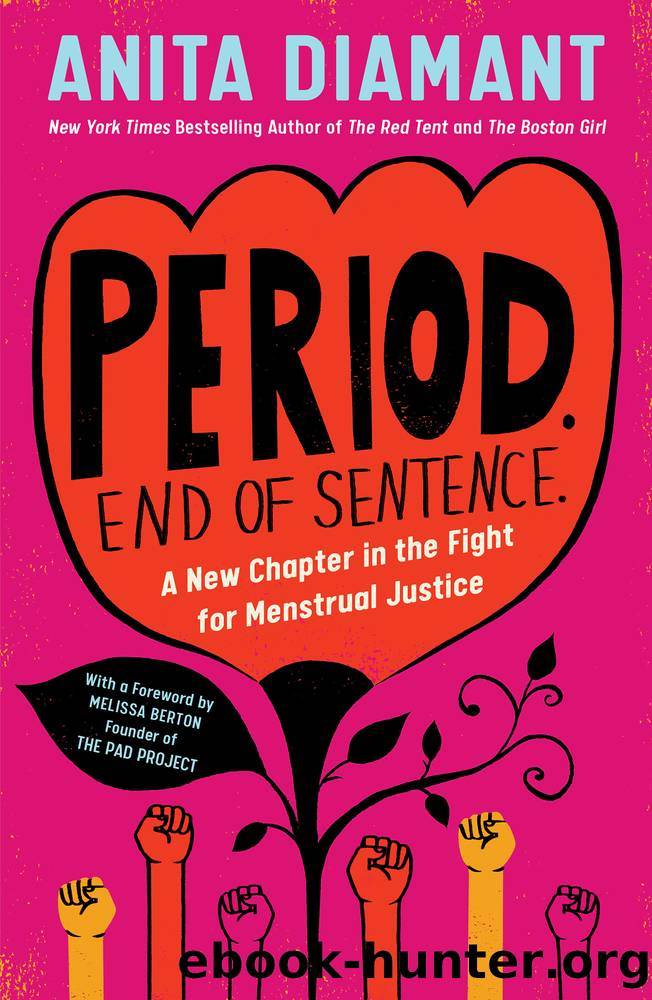Period. End of Sentence. by Anita Diamant

Author:Anita Diamant [Diamant, Anita]
Language: eng
Format: epub
Published: 2021-05-25T00:00:00+00:00
Homeless and Refugee Menstruators
People living on the street and sleeping in shelters, surviving in refugee camps or waiting in immigration lockup, are tired, hungry, and frightened; then they get their period and face nothing but awful choices: beg, borrow, make a pad out of toilet paper, use a sock, or just sit still until itâs dark so no one will see the stains.
Sadly, itâs not difficult to ignore or forget the millions of refugees who are isolated in camps, hidden behind bars, or even locked in cages. Itâs harder to disregard the distress of a homeless woman sitting on the sidewalk in front of your laundromat or to forget the face of a woman who approaches you for help.
In its 2020 update, the National Alliance to End Homelessness reported 219,000 homeless women in the United States: Native Americans and Pacific Island women are four times more likely to be homeless than any other racial or ethnic group and 40 percent of homeless youth identify as LGBTQ or nonbinary.
In Canada, mass homelessness emerged as a national problem in the 1980s as a result of disinvestment in affordable housing and reduced support for social services. By 2019, 235,000 Canadians experienced homelessness at some point in the year, though that number is widely considered an undercount. Twenty-seven percent of the homeless are women, of whom up to 75 percent have a mental illness; domestic violence has been cited as a leading cause of the rise in family homelessness.
The largest Canadian homeless population is in Toronto, which is where special education teacher Jana Girdauskas was approached by a homeless woman who needed help. The encounter set Girdauskas to wondering what happened to homeless women when they got their periods. She decided to be ready with material help the next time she was asked for assistance, so she gathered period supplies and other necessities and put them in a purseâso it would feel more like a gift than a handout. She posted on Facebook to see if any of her friends had a spare pocketbook. Within a month Girdauskas had 350 handbags filled with supplies, which she brought to local shelters; within the year she founded The Period Purse to keep the efforts going. High school and church groups joined in, collecting products and assembling them for delivery to organizations that worked with homeless women. The local media ran stories, familiarizing the public with terms like âmenstrual stigmaâ and âperiod poverty.â Within two years, the Toronto City Council allocated funds for period products in shelters and drop-in centers for the first time, and the Toronto public school system began supplying pads and tampons in its middle and high schools.
The Period Purse story is just one example of efforts in Africa, Europe, the US, and elsewhere that often begins when a woman or teenage girl witnesses an example of menstrual humiliationâon the street or from a news story or a documentaryâand canât look away. She organizes a drive to collect products and distribute them in her
Download
This site does not store any files on its server. We only index and link to content provided by other sites. Please contact the content providers to delete copyright contents if any and email us, we'll remove relevant links or contents immediately.
| Anthropology | Archaeology |
| Philosophy | Politics & Government |
| Social Sciences | Sociology |
| Women's Studies |
On the Front Line with the Women Who Fight Back by Stacey Dooley(4307)
The Lonely City by Olivia Laing(4112)
The Rules Do Not Apply by Ariel Levy(3897)
Bluets by Maggie Nelson(3705)
The Confidence Code by Katty Kay(3561)
Three Women by Lisa Taddeo(2916)
Inferior by Angela Saini(2829)
A Woman Makes a Plan by Maye Musk(2824)
Pledged by Alexandra Robbins(2789)
Not a Diet Book by James Smith(2715)
Confessions of a Video Vixen by Karrine Steffans(2669)
Nice Girls Don't Get the Corner Office by Lois P. Frankel(2590)
Wild Words from Wild Women by Stephens Autumn(2584)
Brave by Rose McGowan(2497)
The Girl in the Spider's Web: A Lisbeth Salander novel, continuing Stieg Larsson's Millennium Series by Lagercrantz David(2379)
The Clitoral Truth: The Secret World at Your Fingertips by Rebecca Chalker(2240)
Why I Am Not a Feminist by Jessa Crispin(2237)
Women & Power by Mary Beard(2221)
Women on Top by Nancy Friday(2120)
